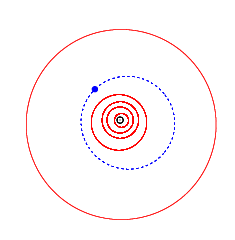9994 Grotius
|
| |||||||||||||
| Discovery | |||||||||||||
|---|---|---|---|---|---|---|---|---|---|---|---|---|---|
| Discovered by | C.J. van Houten, I. van Houten-Groeneveld & T. Gehrels | ||||||||||||
| Discovery date | 24 September 1960 | ||||||||||||
| Designations | |||||||||||||
Named after | Hugo Grotius | ||||||||||||
| 4028 P-L, 1981 WH9 | |||||||||||||
| Orbital characteristics[1] | |||||||||||||
| Epoch 13 January 2016 (JD 2457400.5) | |||||||||||||
| Uncertainty parameter 0 | |||||||||||||
| Observation arc | 20262 days (55.47 yr) | ||||||||||||
| Aphelion | 3.0381069 AU (454.49432 Gm) | ||||||||||||
| Perihelion | 2.1358181 AU (319.51384 Gm) | ||||||||||||
| 2.5869625 AU (387.00408 Gm) | |||||||||||||
| Eccentricity | 0.1743916 | ||||||||||||
| 4.16 yr (1519.8 d) | |||||||||||||
| 61.740450° | |||||||||||||
| 0° 14m 12.749s / day | |||||||||||||
| Inclination | 7.172852° | ||||||||||||
| 207.16998° | |||||||||||||
| 224.44603° | |||||||||||||
| Earth MOID | 1.15585 AU (172.913 Gm) | ||||||||||||
| Jupiter MOID | 2.29082 AU (342.702 Gm) | ||||||||||||
| Jupiter Tisserand parameter | 3.389 | ||||||||||||
| Physical characteristics | |||||||||||||
| 9.2189 h (0.38412 d) | |||||||||||||
| |||||||||||||
| 14.3 | |||||||||||||
|
| |||||||||||||
9994 Grotius is a main belt asteroid. It orbits the Sun once every 4.15 years.[1]
Discovered on September 24, 1960 by C. J. van Houten and I. van Houten-Groeneveld on photographic plates made by T. Gehrels, it was given the provisional designation 4028 P-L. It was later renamed 9994 Grotius, to honour Hugo Grotius.[2]
References
- 1 2 "9994 Grotius (4028 P-L)". JPL Small-Body Database. NASA/Jet Propulsion Laboratory. Retrieved 13 April 2016.
- ↑ MPC 41571 Minor Planet Center
External links
This article is issued from Wikipedia - version of the 9/10/2016. The text is available under the Creative Commons Attribution/Share Alike but additional terms may apply for the media files.
